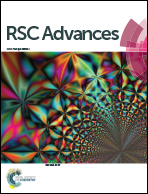A novel mariner-based transposon system for the enhanced removal of high strength ammoniacal nitrogen in pharmaceutical effluents†
Abstract
Industrial wastewater is a major polluting agent in the environment as huge amounts of untreated effluents are discharged from industries causing serious effects to biotic systems. The pharmaceutical industry effluent used in the present study contains a high concentration of ammoniacal nitrogen (NH3–N) about 500 mg L−1. In the present study, an efficient NH3–N removing strain was isolated, and enriched in the effluent with a high NH3–N concentration for its efficient removal. The strain which showed higher removal efficiency was identified as Proteus penneri by ribotyping. The wild type P. penneri exhibited low removal efficiency (64%) in 24 hours even after the conventional enrichment method. Hence, the strain was mutated to improve its degradation efficiency using a modified mariner based transposon system. It was constructed by replacing the Kanr gene with Gmr gene to develop pSC189::miniTn(Gm), since the isolated strain was resistant to kanamycin. Two mutant strains T55 and T132 were shown to have enhanced NH3–N removal efficiency by 84% and 81% respectively, in 24 hours. The kinetic rate constants such as pseudo first and second order kinetics were evaluated for the degradation of NH3–N by wild type P. penneri and transposon mutants; both of them followed second order rate kinetics. The NH3–N removal was confirmed by ion chromatography (IC) and Fourier Transform-Infrared Spectroscopy (FT-IR). To date, there is no report on the strain improvement using transposon mutagenesis for the treatment of NH3–N.


 Please wait while we load your content...
Please wait while we load your content...